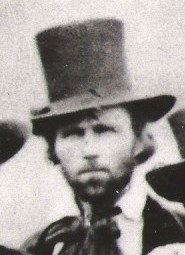Tuesday, December 23, 2014
1010: But How?
Actually, someone just spikes the watercooler water everyday because they work at a dying tea cozy company run by Rancid W. Veeblefester.
Monday, December 22, 2014
1009: HR Wanted Me To Tell You Because They Are Scared of You
It may also help if you kept your sacks of money behind your desk or in a closet where people can't see them. In addition, calling your employees doofuses tends to send out negative connotations.
Sunday, December 21, 2014
1008: The Most Beautiful Tree Must Die
I've always wanted to get a real Christmas tree some year just to say I've had one. I hear they are difficult to deal with and that's the main reason I've never gotten one. I do think that it's too bad that we don't get to see Brutus chop his wife and son into small bits with the axe but that's what happens when you reduce the size of a Sunday comic strip by 75-85% over the last 100 years or so.
What's Wilberforce doing in the last panel? Some kind of weird force field-type thing?
What's Wilberforce doing in the last panel? Some kind of weird force field-type thing?
Wednesday, December 17, 2014
Rev. John E. Stewart
In a continuation of the post last week, another member of The Immortal Ten helped on the Underground Railroad and lived about a mile east of Kennedy Valley.
Reverend John E. Stewart was born in England in 1818 and was a minister in New Salem, New Hampshire before coming to Kansas. Stewart's claim with a few miles southeast of Lawrence along the Wakarusa River. It was near what is now North 1175 Road and East 1600 Road but the exact location of where the house was is unknown.
Stewart operated a branch of the Underground Railroad on his land and helped roughly 70 slaves to freedom from Missouri. Stewart also was a close friend of Charley Hart--better known as William Quantrill. When Stewart found out that Hart was hunting down freed slaves and sending them back to Missouri, Stewart broke off all ties and helped get Hart run out of Lawrence. Hart would return to Lawrence with about 300 additional men during the morning of August 21, 1863.
A couple of portrayals paint Stewart in a different light where he had no regard for property or life and was more than happy using terror and threats to further the abolitionist cause. Stewart married Mary Ann in the late 1850s and remarried to Jenny Blackmar in 1870 and Sarah Hufford after that. He moved to Ohio in 1870 and is buried in Perrysburg.
Sources
John Stewart and Others of the Wakarusa/Kennedy Valley by The Wakarusa Valley Heritage Museum
~*~*~
If you have a story or history that you would like to submit or have me try and research, please let me know using the Contact form. For submissions, please make sure there are sources cited.
Tuesday, December 16, 2014
1007: Does This Make Brutus Crazy Eyes?
The best thing I like about Veeblefester that I have created in my mind and not actually canon is that even though he reaps the benefits of politicians bowing down to the rich and creators of jobs I do not believe he actively donates to them. If Rep. Dingus Q. McMoronaville wants to give him a tax break, great but Veeblefester isn't going to thank him for it.
Monday, December 15, 2014
1006: That Took Brutus Down a Peg
Holy crap that middle panel is scary. Actually, now that I look at it, the first panel is a little frightening too. It's been so long since Chip has drawn someone happy in this strip that he can't do it without making them look like a twisted monster.
Sunday, December 14, 2014
1005: Slick Sammy's, At the Corner of Harvard and East 64th
I assume that you get to take the fridge home. I've never done anything like this so I'm just assuming that you get to take it home and use it but I don't know. I'd be more concerned with doing business with a guy who goes by Slick Sammy.
Saturday, December 13, 2014
1004: What Will the Internet Talk About for the Next 89 Years?
In our lifetime. It won't be sequentially ordered again in our lifetime. January 2, 2103 to be exact. I love how it seems as if Chip is tired of people making big deals about dates, too. I bet Chip has lost a lot of friends due to the dates 10/10/10, 11/11/11, and 12/12/12.
Thursday, December 11, 2014
1003: Shouldn't an Old Person Know All the Remedies?
Brutus, do you really want your last words to your mother-in-law to be an insult on her appearance? What? Oh, you do. Well then please continue.
Wednesday, December 10, 2014
Silas Soule and Sand Creek
In 1851, the Treaty of Fort Laramie recognized that the Cheyenne and Arapaho held territory encompassing land between the North Platte River and Arkansas River from the Rocky Mountains to western Kansas. By 1859, gold was discovered in the Rockies bringing a gold rush to what was then western Kansas Territory. The Cheyenne and Arapaho urged federal authorities to redefine what their lands were and in the fall of 1860, a new treaty was negotiated.
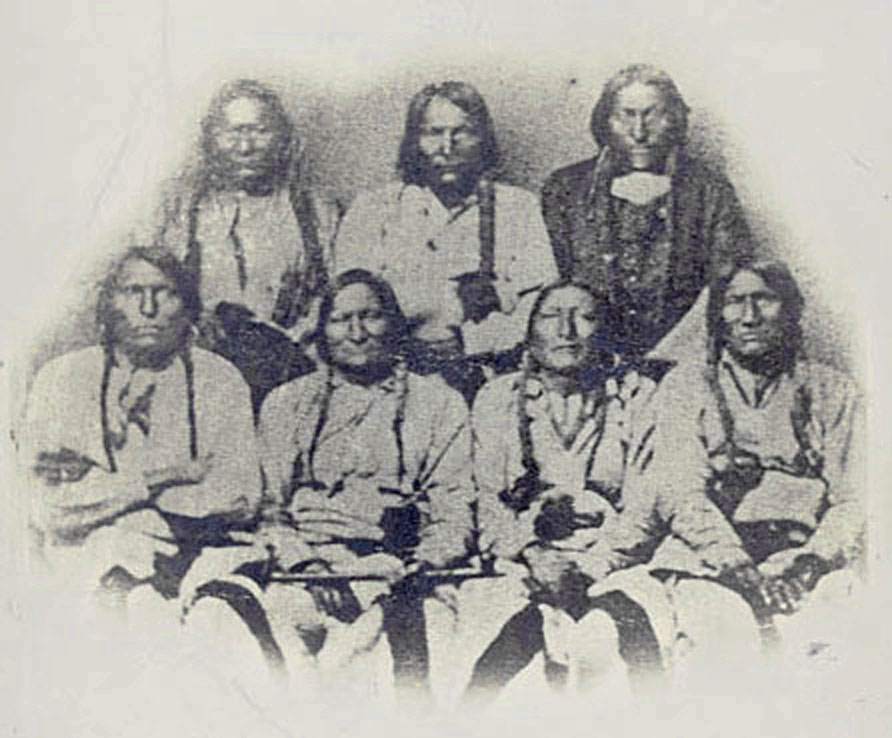 |
| The delegation of Kiowa, Cheyenne and Arapaho chiefs, September 1864. Black Kettle is 2nd from left, front row. Photo: Smithsonian Institute. |
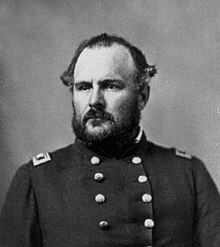 |
| Col. John Chivington |
 |
| Silas Soule, circa 1864-65. Photo: Denver Public Library |
In July 1859, 20 pro-slavery men crossed into Kansas and ambushed a party led by Dr. John Doy who was escorting 13 former slaves to Iowa. The men from Missouri arrested Doy, tried and convicted him sentencing him to five years in prison. Soule and a group of other men decided to free Doy, overpowered the jailer, freeing Doy and leading him across the border back to Kansas. When they got back to Lawrence, their photo was taken. The photo, called The Immortal Ten, is widely circulated and a Kansas icon. Soule was also tasked with freeing John Brown after he was captured after his raid on Harper's Ferry. Brown allowed himself to be hanged hoping his death would start a war. Soule then tried to free two of Brown's men who refused to come with him.
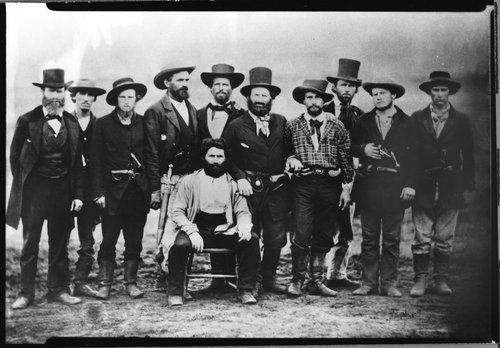 |
| The John Doy rescue party "The Immortal Ten." Doy is seated. Soule is 2nd from the right. Photo: Amon Gilbert DeLee, courtesy Kansas State Historical Society. |
The Army investigated what would become the Sand Creek Massacre and Soule testified against Chivington in court in January 1865. Soule was married to Hersa Coberly in March of 1865 and was on duty as a Provost Marshal in Denver on April 23, 1865 when shots rang out. One of the bullets hit Soule in the head, killing him almost instantly. It is believed that someone who was a supporter of Chivington did the killing or ordered it. The murderer was never brought to justice. Soule was buried in Denver's historic Riverside Cemetery and is remembered every year during remembrance ceremonies of the Sand Creek Massacre where the graves of Soule and Cramer are decorated. A plaque commemorating Soule was also placed on a building at 15th and Arapaho in Denver.
 |
| Soule's gravestone in Riverside Cemetery in Denver, Colorado. Courtesy FindAGrave. |
1002: Hail the Tea Cozy King
There is something to be said about a man who can manage a tea cozy conglomerate in this economy and still produce a profit.
Tuesday, December 09, 2014
Monday, December 08, 2014
1000: Has Brutus Seriously Never Heard That Saying Before?
An itchy nose means that you are about to kiss a fool so the joke is on Gladys, or should I say, fool?
Additional original content will be returning later this week. I'm hoping to have at least one thing posted every week and something else every two weeks or so. Because of this, original content will no longer be posted at The Point of Beginning. I'm not sure what I'm going to do with that site but it will probably be coming to an end at some point in the future.
Additional original content will be returning later this week. I'm hoping to have at least one thing posted every week and something else every two weeks or so. Because of this, original content will no longer be posted at The Point of Beginning. I'm not sure what I'm going to do with that site but it will probably be coming to an end at some point in the future.
Sunday, December 07, 2014
999: And You Know Brutus' Ringtone Is That Generic Nokia One
Who is calling Brutus? Everyone Brutus knows is at this staff meeting and I'm pretty sure Wilberforce's school would call Gladys if Wilberforce was sick or hoisted up the flagpole again and we all know Gladys would rather die than call Brutus for anything so I'm going to say the important policy meeting is being interrupted by a wrong number. Classic Brutus.
Sunday, November 30, 2014
998: At Least We'll Get To Hear Brutus Scream "Oh, My Nose!"
I was hoping for Wilberforce to come running up to kick the football and then at the last minute Brutus pulls the football away causing Wilberforce to land painfully on his back just like Charlie Brown.
Friday, November 28, 2014
997: Thanksgiving Poison Coma
Over the last couple of years, Gladys has been shown to be a good cook so when Brutus makes fun of her culinary prowess, it always feels disingenuous. But what's really interesting is that it looks like they are eating the pies first.
Clearly the food wasn't terrible-tasting since Brutus ate too much yesterday. Although I guess it's possible that Gladys poisoned the food. Maybe that's why they started with the pie and everybody got their own!!
Wednesday, November 26, 2014
Tuesday, November 25, 2014
995: But Brutus Doesn't Have a Cell Phone
Brutus strikes me as a person who wouldn't want to leave a voice mail. I hate leaving messages on answering machines. When I have to leave a message, my hands get all clammy and I sweat and I get dizzy. One time I wound up in the hospital...
Monday, November 24, 2014
994: And Who Is Gladys Looking At?
I weighed myself last night and I was very disappointed with the results. I know what my New Years Resolution is going to be for 2015.
Anyway, what's Brutus drinking? It looks like chocolate milk. When is Gladys going to eat? She's still in her apron. Is this lunch or dinner? Why does Brutus have to beg his wife for seconds? This strip isn't very well plotted out.
Anyway, what's Brutus drinking? It looks like chocolate milk. When is Gladys going to eat? She's still in her apron. Is this lunch or dinner? Why does Brutus have to beg his wife for seconds? This strip isn't very well plotted out.
Sunday, November 23, 2014
993: Shut Up and Get My Doughnuts
I love doughnuts. I do not like ordering doughnuts. I always feel like I'm ordering too many or getting that one doughnut that they make but no one ever buys so when I order it their thinking: "Does he really like those or is this his first time eating doughnuts?" I don't know. I don't understand why ordering a simple doughnut can fill me with self-conscious anxiety.
Saturday, November 22, 2014
The Douglas County Poor Farm
The poor house was a social institution that dates back to 1697 when the first English workhouse opened in Bristol, England. The poor house came along due to parameters set by Queen Elizabeth I in 1601 which called for taxes to be collected and the creation of almshouses for the aged, infirmed, mothers of illegitimate children and children incapable of work. It was important legislation because it established state responsibility for the poor and began a standard by which care should be delivered.
The English law followed colonists to America and the first public almshouse in America was started in Philadelphia in 1731. All residents—lame, sick, vagrants, aged, children, unmarried mothers, blind and able-bodied poor—were housed together and worked for their keep. In Midwestern states, the almshouses were typically called “poor farms” and it was run as exactly that. Male residents tended animals and crops and performed routine maintenance. Women took care of the house and household chores.
The first poor farms in Kansas were started in Leavenworth and Douglas Counties in 1866. By 1899, eighty of the 105 counties had poor farms. The poor farm in Douglas County was first organized in 1866 when the county commission minutes showed of purchase of a 160-acre farm from George Sterns for $2,200.
The 160 acres was located one and one quarter mile south of 31st Street and Haskell Avenue on the south side of the Wakarusa River. The legal boundaries of the property were the northwest quarter of Township 13, Range 20 and Section 20 and according to a 1857 map of Douglas County, the property was owned by R.P. Moore at some point the property came under the ownership of George Sterns.
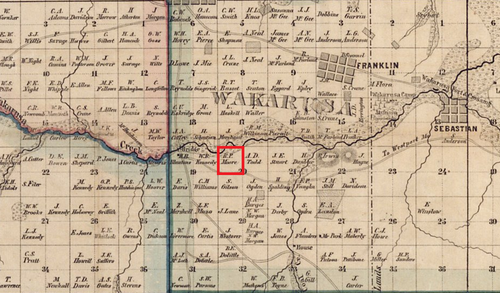 |
| 1857 Plat map of Douglas County. R.P. Moore land highlighted. |
Census records from 1870 list twelve residents of the farm. Two males were listed as “farm laborers” and a woman was “keeping house.” Six ‘paupers,’ ranging from 2-year-old Willy to an 80-year-old man, were listed as illiterate, and one was designated an ‘idiot.’ People on the farm worked if they were able to. They maintained the house, tended crops, fed livestock—which mainly consisted from cows, pigs and chickens—and women usually did house work including cooking, cleaning and laundry.
In 1887, the Poor Farm’s superintendent was a Mr. Dodge who was described by some as a “common drunkard” and “a profane and brutal man.” When an aged Irishman died at the farm and was buried unceremoniously in the farm cemetery on the bank of the Wakarusa River, George Hollingberry expressed his unhappiness with the neglect and mistreatment of the county home to the Lawrence Daily Journal and county commissioners. While several people testified that Mr. Dodge was a good farmer, they still felt he should be removed as superintendent of “The Home.”
 |
| 1887 Plat map showing the Poor Farm property in red. The main road to the Farm veers to the southeast before crossing the Wakarusa River over an iron bridge. |
A list of names recorded by the poor farm and submitted to the Douglas County commission shows that the poor farm assisted 109 people between 1909 and 1910 and this was in addition to the people whose residence was at the farm. Most of the patrons were from Lawrence but Lecompton, Eudora and Baldwin City were represented as were Lone Star, Lecompton Township and Vinland.
One of the more interesting names on the list is a Mrs. Mary Henderson who doesn’t have an address listed next to her but “Cocain Mary.” From what I found in newspaper archives, “Cocaine Mary” was an interesting character in Lawrence. Mentions of her in the various newspapers report her many arrests due to drugs and drunkenness. In 1910, she was shot at a party in Bloomington but it was unclear whether someone shot her or she shot herself. After accosting people heading to the Santa Fe Depot at 7th and New Jersey Streets, Mary was arrested and put on trial to determine if she should be remanded to the custody of the county. She was declared unfit to care for herself but, having no relatives and being unable to find anyone to take up the burden, she was released back into society. She is listed as being arrested again with a “Mexican friend whose name can’t be written” for indecent conduct. After that incident, news on “Cocaine Mary” ceased.
Deciding that it was time to expand the poor farm, county commissioners accepted the construction bid from John H. Petty of $22,944.00 to construct a two-story, brick structure with large pillars in front. Commissioners formally accepted the building on March 13, 1911 finding it “according to contract in every respect.” The old frame house was torn down.
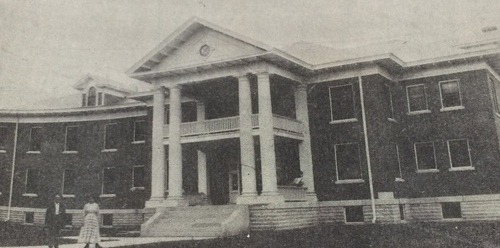 |
| 1911 Douglas County Poor Farm |
On March 15, 1927, a barn was destroyed by fire. W.J. Welshimer had been dismissed from the farm earlier that day and was later convicted of arson in the fourth degree. When he appeared for sentence at the jail, he stated “you wouldn’t keep me at the County Home, so I had to fix it so you would keep me some place.”
Aside from the occasional news report, life at the poor farm was quiet and peaceful. The farm provided most of its own food and raised livestock but tragedy struck in the early morning hours of April 11, 1944.
Superintendent George Hoskinson was awakened by the screams of two elderly men in the basement. George rushed to fight the flames while his wife went to a nearby farm to call the fire department. By the time the fire department arrived, flames had already engulfed the building. Hoskinson and six other employees were able to rescue the 26 residents. Eight residents burned to death in the fire. Mr. Hoskinson said that he helped one inmate out twice but she returned to the building and died in the flames. Another man, 69-years-old, was taken to Lawrence Memorial Hospital with both legs fractured having either fell or jumped from a second story window.
The fire could clearly be seen from Lawrence and later that day, Coronor C.B. Ramsey assembled a jury to visit the ruins of the home to gather evidence and to remove the remains of the deceased. With the help of the Red Cross, inmates were cared for at the Community Building at 11th & Vermont Streets until arrangements could be made for their care. Fire Chief Paul Ingels surmised that the fire started in a fusebox. County Commissioners also announced the next day that a small farmhouse would be built southwest of the poor farm ruins using salvageable material from the gutted building. The county sold the livestock and equipment and finally the land in 1946.
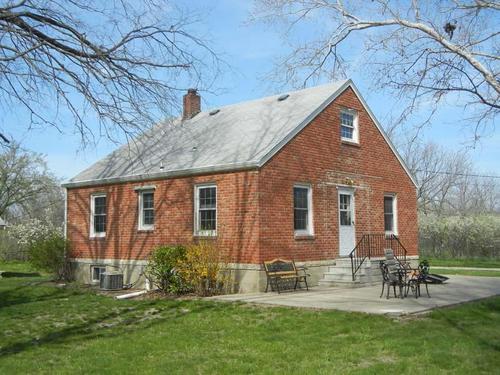 |
| The farmhouse built from the ruins of the Douglas County Poor Farm, circa 2013. Photo by Dale Nimz. |
Lucius H. Perkins was born in Racine County, Wisconsin on March 5, 1855. His parents, natives of Onondaga County, New York, were among the pioneers of southeastern Wisconsin. Perkins ancestry appeared as early as the tenth century and possessed large estates surrounding Ufton Court in Berkshire. The first Perkins to come to America was John W. who arrived in 1631 aboard the Lion and became a member of the Massachusetts Bay Colony at Ipswich. He later moved to Norwich, Connecticut where they remained for nearly 200 years when they moved to New York.
In 1877, Lucius graduated from Beloit College and moved to Lawrence where he became a student of law in the office of Judge Solon O. Thacher. After two years, he became a member of the first graduating class of the University of Kansas School of Law. He was one of the first to be appointed on the State Board of Law Examiners and retained that position until his death.
On May 15, 1882, Mr. Perkins married Clara Morris. They had four children, Bertram (1883-1887), Clement (1885-1966), Rollin (1889-1993) and Lucius J. (1897-2003). Mr. Perkins was fond of travel, devotedly attached to his home, loved the companionship of his fellow men and opened his home, a stately house he named Ufton Court, after his ancestral home in Berkshire, designed by John G. Haskell, 25 rooms, three-stories with a red tile roof and decorative tower, for all the neighboring boys. Mr. Perkins died suddenly at his home on June 1, 1907 from a fall at his house.
 |
| 1907 Lawrence Daily Journal photograph of Ufton Court the day after Perkins died. |
After Perkins’ death, the house was sold to the Alpha Tau Omega fraternity. During World War II, the house was renamed Victory Mansion and was a home for employees of the Sunflower Ordinance Plant in DeSoto. The county bought the house the day after the fire and in September of that year, the Douglas County Convalescent Hospital opened with 31 beds. Through the years numerous additions would be added on but the building had problems.
“It wasn’t what you would call a safe place for old people,” Douglas County Commissioner Walter Kampschroder remembered. “[T]he state health department got to checking and […] they were putting quite a bit of heat on us,” he said. On November 4, 1958, voters narrowly approved the construction of a new county nursing home. Two years later, voters approved the sale of the old home which was purchased by the Medical Arts Center and razed in 1962 for a parking lot.
The Valleyview Care Home opened in April 1961 at 2518 Ridge Court with 51 beds. The county leased the home to private operators and paid a monthly fee for all county partners. In 1975, commissioners were urged to return as the operators of the home since “maintaining […] profit was the prime concern of […] private operators.” The county took charge of the home the remainder of the time it was open.
 |
| The United Way Building, formerly the Valleyview Care Home, in 2014. |
In 1996, the United Way of Douglas County purchased the building to use as their offices along with the offices of numerous other charities such as the Red Cross, Girl Scouts, Big Brothers Big Sisters and Tenant to Homeowner. The Poor Farm is marked today by the farmhouse built in 1944, a barn and silo on the south side of North 1175 Road, a chicken coop and root cellar.
The Poor Farm Cemetery and Deaths
The Douglas County Poor Farm Cemetery was “situated on the banks of the Wakarusa River in a narrow strip of land between the river and the road”, was supposedly unmarked and used throughout the years as a cow pasture where the land was desecrated by rooting pigs and the tramp of horses and cows. The exact location of the cemetery is unknown and it’s suggested that it no longer exists due to the change in the Wakarusa River’s channel.
The only cemetery records for the poor farm exist in mortuary records from C.W. Smith. It shows only the burials that C.W. Smith Mortuary handled for the poor farm. Known burials in the Poor Farm Cemetery are:
- Joseph Franklin, buried Dec. 16, 1893, aged 64
- Infant Furgason, buried Jan. 4, 1891, no age given
- Child Hattan, buried Apr. 28, 1893, no age given
- Infant Edwards, buried Nov. 25, 1901, stillborn
- Minnie Anderson, buried Jan. 19, 1894, no age given
- Daniel Barkley, buried Jan. 23, 1895, no age given
- Mrs. Lowe, buried Oct. 21, 1891, no age given
- Carrie Low(s), buried January 1893
- Unknown Sukey, buried Feb. 11, 1891
- Unknown Jackson, buried July 3, 1892
- Child of Carder, buried Apr. 22, 1893
- Ora Wright, buried May 10, 1892
- Mrs. Albert Bebout, 86, Lawrence, buried in Oak Hill Cemetery, Lawrence
- Mrs. Ida Clark, 80, Lecompton, buried in Maple Grove Cemetery, Lecompton
- Miss Elizabeth Whitelaw, 76, Topeka, buried in Oak Hill Cemetery, Lawrence
- Peter Luzius, 83, Lawrence, buried in Oak Hill Cemetery, Lawrence
- Fred W. Plateman, 88, Big Springs,
- William St. Clair, 88, Big Springs, Maple Grove Cemetery, Lecompton
- Isaac Tabor, 71, Lawrence,
- Lafayette Tabor, 82, Lawrence, buried in Beulah Cemetery, Colby
The Complete Tombstone Census of Douglas County, Kansas Volume 2 by Jean Snedeger, Douglas County Genealogical Society, 1988.
Douglas County Poor Farm files, Watkins Museum of History, Lawrence, Kansas, accessed 2014.
The Jeffersonian Gazette, April 6, 1910
The Lawrence Daily Journal, January 23, 1887
----- January 28, 1888
-----June 3, 1907
Lawrence Daily Journal-World, July 27, 1915
Lawrence Daily World, November 23, 1909
-----February 7, 1910
Lawrence Journal-World, April 13, 1944
-----April 14, 1944
-----October 18, 1981
Standard History of Kansas and Kansans by William E. Connelley, 1918.
Originally published on The Point of Beginning on November 17, 2014.
Sunday, November 02, 2014
Saturday, November 01, 2014
991: Isn't There a Football Game On or Something?
Who the hell watches workout show on TV if you aren't going to workout? That just sounds like the worst thing ever.
Friday, October 31, 2014
990: I Mean, Seriously, Columbus Day?!!
As you may have noticed, I am taking a small hiatus from The Point of Beginning for a couple of weeks. I'm trying to get a bunch of writing done and posts queued up here before doing the randomness that is POB. I'm hoping to get new stuff posted here sometime in November but I'm trying to work up a backlog so I don't have to worry about it as much. In the meantime, hope you're still okay with The Born Loser.
At least he's not texting and driving. But I guess that wouldn't matter since Veeblefester has a chauffeur. Also, Veeblefester is a rich, white man who would be able to hire a bunch of lawyers who could make it so he'd only serve maybe community service if he happened to hit a stupid child who couldn't move out of the way of his speeding car.
We have enough holidays we get time off for, Wilberforce. We seriously need to readjust our federal holiday calendar.
At least he's not texting and driving. But I guess that wouldn't matter since Veeblefester has a chauffeur. Also, Veeblefester is a rich, white man who would be able to hire a bunch of lawyers who could make it so he'd only serve maybe community service if he happened to hit a stupid child who couldn't move out of the way of his speeding car.
We have enough holidays we get time off for, Wilberforce. We seriously need to readjust our federal holiday calendar.
Wednesday, October 29, 2014
989: That's the Look of a Teacher Who Has Just Given Up
I'm a bit worried that Wilberforce made it all the way third grade (?) not knowing what a consonant is. Maybe Wilberforce has a hearing problem. Maybe he should go to the nurse's office and listen to some tones.
Tuesday, October 28, 2014
988: How Can Brutus Watch Baseball and Not Be Drinking?
Shouldn't this strip have been published a week or so ago and not on the day that Game 6 is being played?
Also, Gladys is a modern woman in America. She can't do what she wants and doesn't need your ignorant invitation, Brutus.
Also, Gladys is a modern woman in America. She can't do what she wants and doesn't need your ignorant invitation, Brutus.
Monday, October 27, 2014
Sunday, October 26, 2014
986: I've Heard Chicken Livers
Once again we see Brutus at a fancy restaurant (so fancy the waiters actually come from France) all by himself. Does he ever take Gladys to these fancy restaurants? Does Chip go to fancy restaurants by himself all the time?
Saturday, October 25, 2014
Friday, October 24, 2014
984: Was the Doctor Even Really There?
The strip alludes to Brutus not being able to pay for his visit which is why the doctor isn't there. He ran off because it is against the therapist's code to listen to someone complaining about their life without getting compensated at some point. But what I think happens is that the doctor is never there on Friday's and his assistant just lets Brutus in so he can ramble on about nothing to an empty chair.
Thursday, October 23, 2014
Wednesday, October 22, 2014
982: Ha! Veeblefester Hires Terrible Employees
I've worked many soul-sucking jobs. You could hear part of your soul dying every time the doors opened into the recycled air-filled building. For most of my job career I talked to the elderly about their insurance. It could be very depressing and could wear on you depending on the calls you took. I was always considered, and knew I was, the more negative of the people I worked with. Mainly I was negative because of the system. I wanted to help these people but knew I couldn't and could do nothing to change it.
My job these days is more upbeat. I actually get to help people and it's one of the few jobs I actually like. I am no longer the "negative one." That role has fallen to about 30% of my coworkers and that crap is more grating on you than hearing about how someone is going to die if they can't get Medicare to pay for something. They complain about the kids, the teachers, the parents, the lack of God and basically everything else. I'd actually complain if I knew something would be done but I know nothing will be.
My job these days is more upbeat. I actually get to help people and it's one of the few jobs I actually like. I am no longer the "negative one." That role has fallen to about 30% of my coworkers and that crap is more grating on you than hearing about how someone is going to die if they can't get Medicare to pay for something. They complain about the kids, the teachers, the parents, the lack of God and basically everything else. I'd actually complain if I knew something would be done but I know nothing will be.
Monday, October 20, 2014
981: It Happens So Often That Brutus Is Immune to the Yells
I like to imagine Veeblefester just goes up to employees and starts screaming "No! NO! NO!" in their face.
Sunday, October 19, 2014
980: Pumpkin Spice Makes Me Angry Too
If you are trying to be nice to someone, why would you get them something only a percentage of people actually like. "But everyone likes pumpkin spice crap." Yeah, they like it about as much as they like McRibs and Shamrock Shakes.
Subscribe to:
Posts (Atom)




